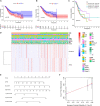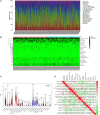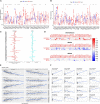Significance of Tumor Mutation Burden Combined With Immune Infiltrates in the Progression and Prognosis of Advanced Gastric Cancer
- PMID: 34306002
- PMCID: PMC8299211
- DOI: 10.3389/fgene.2021.642608
Significance of Tumor Mutation Burden Combined With Immune Infiltrates in the Progression and Prognosis of Advanced Gastric Cancer
Abstract
Gastric cancer (GC) is a serious malignant tumor with high mortality and poor prognosis. The prognosis and survival are much worse for advanced gastric cancer (AGC). Recently, immunotherapy has been widely promoted for AGC patients, and studies have shown that tumor mutation burden (TMB) is closely related to immunotherapy response. Here, RNA-seq data, matched clinical information, and MAF files were downloaded from the cancer genome atlas (TCGA)-STAD project in the TCGA database. The collation and visual analysis of mutation data were implemented by the "maftools" package in R. We calculated the TMB values for AGC patients and divided the patients into high- and low-TMB groups according to the median value of TMB. Then, the correlation between high or low TMB and clinicopathological parameters was calculated. Next, we examined the differences in gene expression patterns between the two groups by using the "limma" R package and identified the immune-related genes among the DEGs. Through univariate Cox regression analysis, 15 genes related to prognosis were obtained. Furthermore, the two hub genes (APOD and SLC22A17) were used to construct a risk model to evaluate the prognosis of AGC patients. ROC and survival curves and GEO data were used as a validation set to verify the reliability of this risk model. In addition, the correlation between TMB and tumor-infiltrating immune cells was examined. In conclusion, our results suggest that AGC patients with high TMB have a better prognosis. By testing the patient's TMB, we could better guide immunotherapy and understand patient response to immunotherapy.
Keywords: advanced gastric cancer; bioinformatics analysis; immune infiltration; prognosis; tumor mutation burden.
Copyright © 2021 Guo, Liang, Wang, Cheng, Zhang, Qin and Wang.
Conflict of interest statement
The authors declare that the research was conducted in the absence of any commercial or financial relationships that could be construed as a potential conflict of interest.
Figures








Similar articles
-
Significance of Tumor Mutation Burden in Immune Infiltration and Prognosis in Cutaneous Melanoma.Front Oncol. 2020 Sep 18;10:573141. doi: 10.3389/fonc.2020.573141. eCollection 2020. Front Oncol. 2020. PMID: 33072607 Free PMC article.
-
Exploration of the relationships between tumor mutation burden with immune infiltrates in clear cell renal cell carcinoma.Ann Transl Med. 2019 Nov;7(22):648. doi: 10.21037/atm.2019.10.84. Ann Transl Med. 2019. PMID: 31930049 Free PMC article.
-
Identification of a Gene Prognostic Model of Gastric Cancer Based on Analysis of Tumor Mutation Burden.Pathol Oncol Res. 2021 Sep 10;27:1609852. doi: 10.3389/pore.2021.1609852. eCollection 2021. Pathol Oncol Res. 2021. PMID: 34566519 Free PMC article.
-
Multi-omics analysis of tumor mutation burden combined with immune infiltrates in melanoma.Clin Chim Acta. 2020 Dec;511:306-318. doi: 10.1016/j.cca.2020.10.030. Epub 2020 Oct 24. Clin Chim Acta. 2020. PMID: 33164879
-
Significance of tumor mutation burden combined with immune infiltrates in the progression and prognosis of ovarian cancer.Cancer Cell Int. 2020 Aug 5;20:373. doi: 10.1186/s12935-020-01472-9. eCollection 2020. Cancer Cell Int. 2020. PMID: 32774167 Free PMC article.
Cited by
-
Identification of SLC22A17 DNA methylation hotspot as a potential biomarker in cutaneous melanoma.J Transl Med. 2024 Oct 2;22(1):887. doi: 10.1186/s12967-024-05622-9. J Transl Med. 2024. PMID: 39358721 Free PMC article.
-
Genomic Landscape of Late-Stage Gastric Cancer: Analysis From KEYNOTE-059, KEYNOTE-061, and KEYNOTE-062 Studies.JCO Precis Oncol. 2025 Mar;9:e2400456. doi: 10.1200/PO-24-00456. Epub 2025 Mar 21. JCO Precis Oncol. 2025. PMID: 40117530 Free PMC article.
-
Gastric adenocarcinoma with high‑level microsatellite instability: A case report.Mol Clin Oncol. 2023 Jan 26;18(3):16. doi: 10.3892/mco.2023.2612. eCollection 2023 Mar. Mol Clin Oncol. 2023. PMID: 36798468 Free PMC article.
-
Cell-in-cell associated lncRNA signature predicts prognosis and immunotherapy response in gastric cancer.Front Oncol. 2025 Jul 8;15:1597187. doi: 10.3389/fonc.2025.1597187. eCollection 2025. Front Oncol. 2025. PMID: 40697378 Free PMC article.
-
A molecular classification of gastric cancer associated with distinct clinical outcomes and validated by an XGBoost-based prediction model.Mol Ther Nucleic Acids. 2022 Dec 27;31:224-240. doi: 10.1016/j.omtn.2022.12.014. eCollection 2023 Mar 14. Mol Ther Nucleic Acids. 2022. PMID: 36700042 Free PMC article.
References
LinkOut - more resources
Full Text Sources
Miscellaneous

